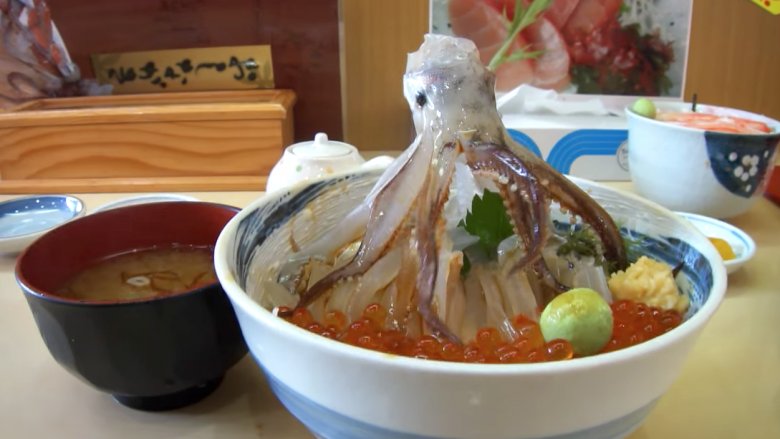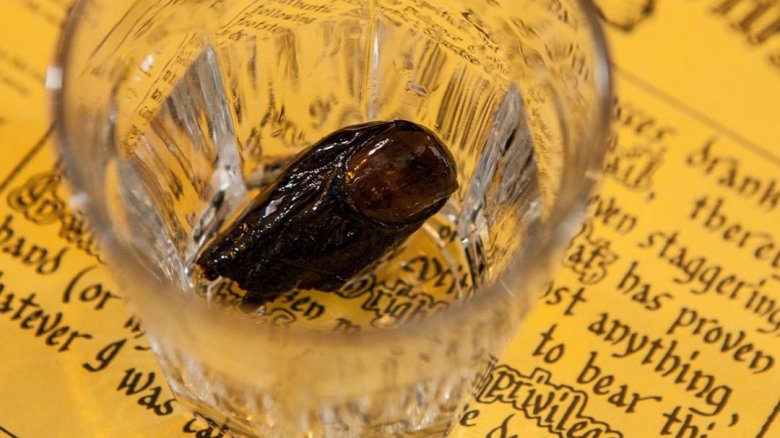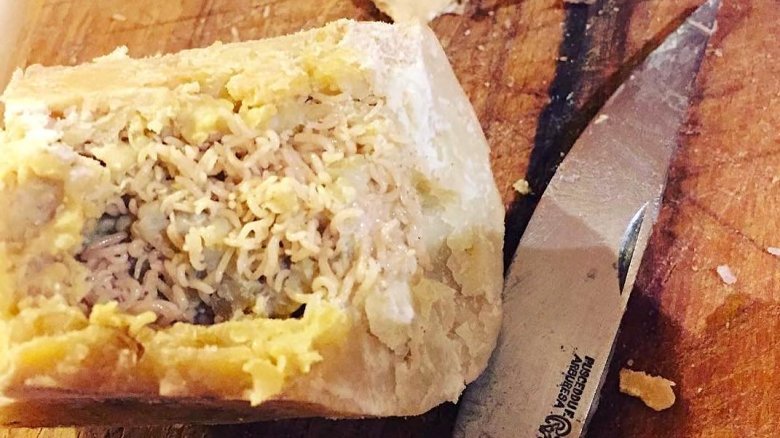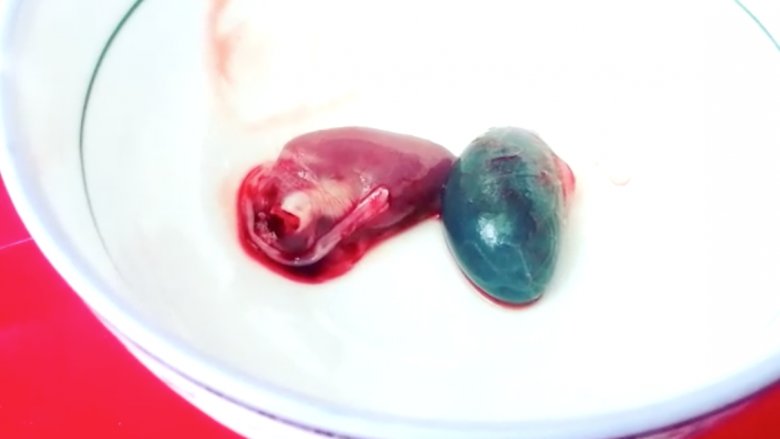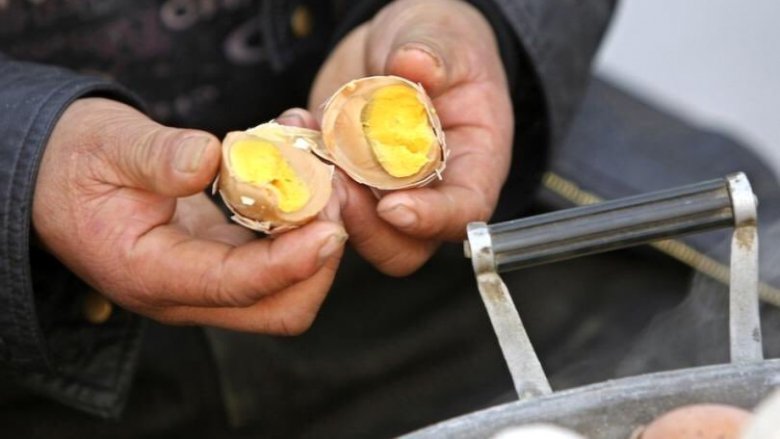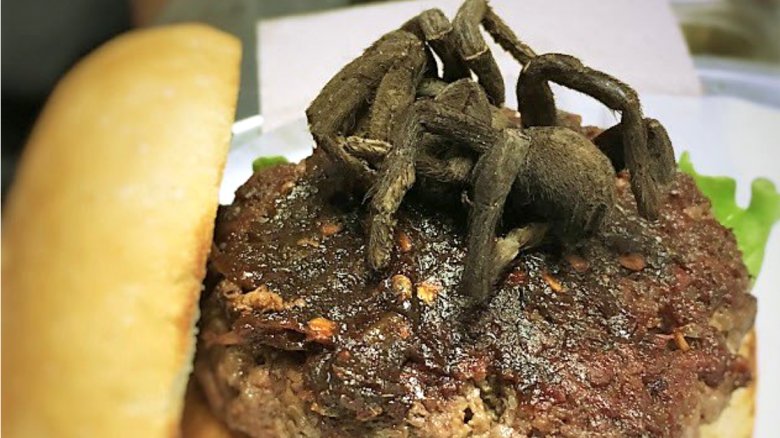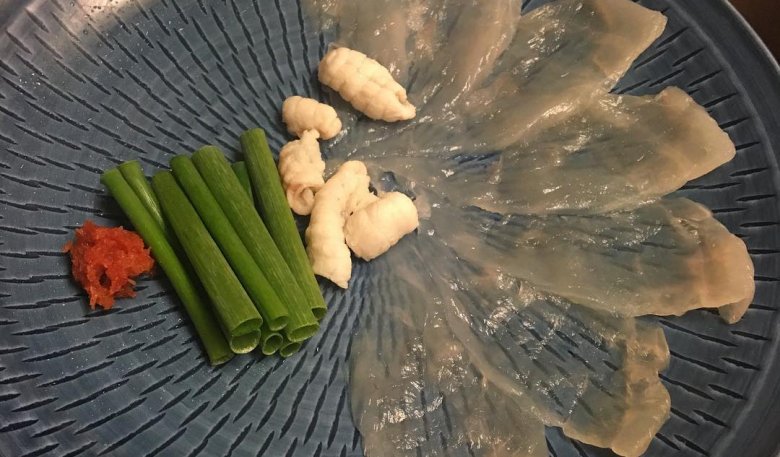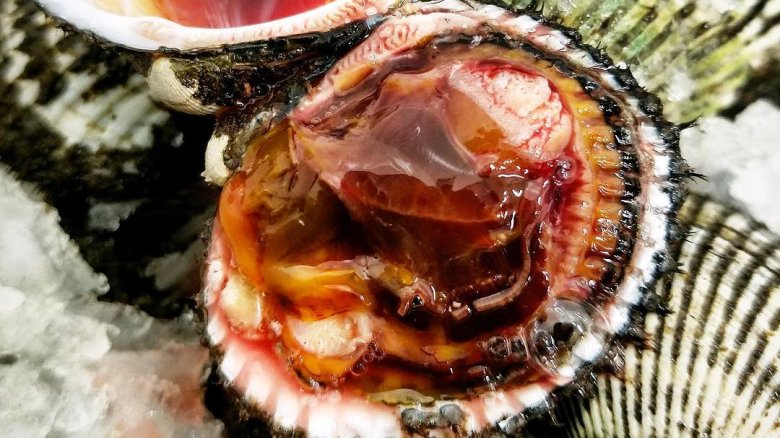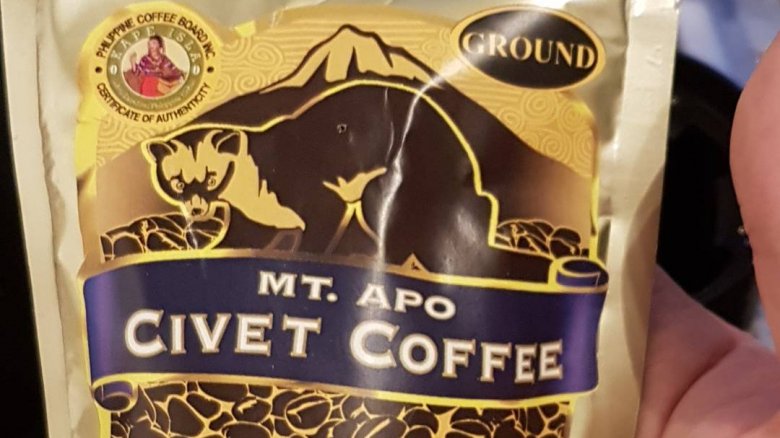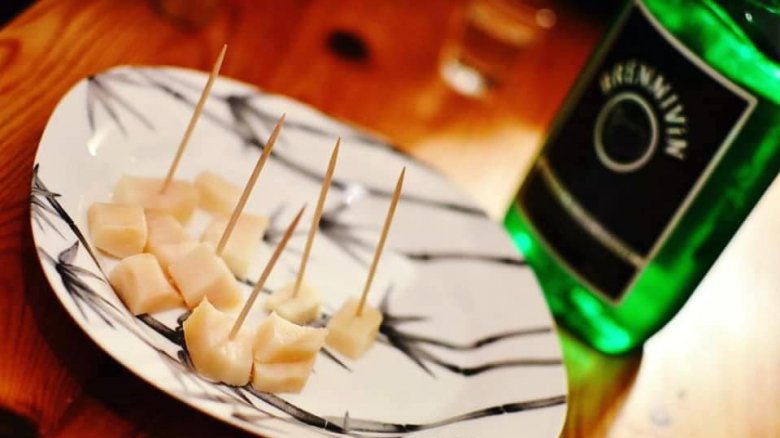Scary Foods People Actually Want To Eat
Hot dogs made of mystery meat? Drive-thru lunches five days a week? Unrecognizable leftovers getting a little fuzzy? Yes, yes, and, unfortunately, yes. Day in and day out, we willingly subject ourselves to some pretty questionable meal choices that have somehow become our norm. Even if they aren't the most nutritious, healthiest, or safest options, these foods are firmly within our comfort zone.
If you're willing to step outside of that comfort zone — way out, in some cases — you'll open yourself up to a whole new world of questionable eats you probably didn't even know existed. Some that could actually kill you, some that are just plain creepy, and some that will make you say, "Why, God, why?!" From severed toe cocktails to still-beating cobra hearts, there's no shortage of scary foods out there, and we've rounded up some of the best (or worst, depending how you look at it). But be warned: Some of this fare just might make you lose your drive-thru lunch.
Still-squirming octopus
You might remember the 2010 viral video of the dancing squid bowl — chances are if you've seen it, you haven't forgotten the shockingly scary display.
Sannakji, or "wriggling octopus," is a raw Korean delicacy which, when doused in soy sauce, writhes around the plate as if it's alive. The good news though — if you can call it that — is that the squid actually is dead, and the reaction diners witness is simply the latent electrical impulses in the muscle neurons that are activated by the sodium chloride in the soy sauce. But don't let your guard down too quickly — just because the sannakji is technically dead doesn't mean it can't kill you. Those tentacles are still rocking and rolling as you eat, and pose a very real choking hazard if the suction cups attach to your throat. Travel + Leisure reports that the dish kills six people per year in South Korea, so proceed with caution and chew, chew, chew.
Sourtoe Cocktail
Those with weak stomachs in Dawson City, California, knew to avoid the Sourdough Saloon. On the other hand, those with a penchant for preserved human toes in cocktails were quick to visit the saloon and join the Sourtoe Cocktail Club.
Joining the club was easy: All you had to do was ask for Captain River Rat, buy a shot, pledge the "Sourtoe Oath," and then drink your Sourtoe Cocktail, which, yes, was an actual dehydrated toe plopped into your shot. Oh, and don't forget this very important rule: "You can drink it fast, you can drink it slow, but your lips have gotta touch the toe."
The bizarre cocktail made its first appearance in 1973 when Captain Dick Stevenson, a Yukon local, found a jar containing the preserved toe of miner and rum-runner Louie Liken while cleaning out an old cabin. Rather than hurl the jar into the woods, it was inexplicably decided that the toe should instead be dropped into shots of booze. Why not? Since its inception, ten more toes have been donated for the cause. Ten. Human toes.
The Sourdough Saloon closed it's doors in 2017, but locals are still hoping for someone to purchase the location and bring back the toe-sipping saloon.
Maggot cheese
We always want what we can't have, even when that thing we can't have is maggot cheese. That's right — casu marzu, or maggot cheese, is illegal in the EU, but that doesn't stop bizarre food lovers from seeking it out, health risks and legal ramifications be damned.
This Sardinian delicacy is made with larvae-infested sheep's milk, and it supposedly tastes like very ripe Gorgonzola thanks to the acid from the maggot's digestive systems. Yum? The problem with casu marzu is that to eat it the maggots must be alive, and although they are to be removed prior to consumption, any sneaky remaining maggots can end up having a party in your intestines. This, as you can imagine, leads to vomiting and a whole host of other undesirable effects. So why not just wait until the maggots are dead? Dead maggots actually indicate that the cheese has spoiled, and we certainly wouldn't want to eat spoiled cheese when we could be eating delicious live maggot cheese, would we?
Still-beating cobra heart
If ever there was a food that made human toes and maggot cheese sound like child's play, it's still-beating cobra hearts.
This scary Vietnamese delicacy, said to enhance a man's virility, is only the beginning of your snake-centric meal — along with the heart comes blood, bile, and countless courses featuring the remaining meat. But the heart is the star of the show, and once it's cut out of the cobra, it gets dropped into a shot glass containing a mixture of blood and rice wine. If you can manage to get that down, bravo, but you have something even better to look forward to: You might feel the heart still beating in your stomach for several minutes. Don't worry though, bright green cobra bile makes the perfect chaser.
Cutting a heart out of a cobra is as brutal as it sounds, and after Gordon Ramsay took part in the practice, he was widely criticized by animal rights groups. Andrew Tyler, director of Animal Aid, said, "Clearly Gordon Ramsay is complicit in an act of cruelty to an animal, something that would be a criminal offense if it happened in Britain. Snakes can feel pain like any other animal and there is no excuse for this. His macho posturing, and this disgusting scene in particular, suggests he is insecure in his masculinity." So maybe he did need that virility boost after all?
Urine-soaked eggs
Bored with regular ol' hard-boiled eggs? Give virgin boy eggs a try! Or don't, because they're eggs cooked in urine for a whole day — specifically the urine of boys under the age of ten.
The eggs, which have been made in the Chinese city of Dongyang for centuries, are cooked in large pots of urine that gets collected daily from primary schools. Nobody can say for sure why it has to be young boy urine — it's simply tradition, and traditions aren't meant to be broken. After a long process of soaking and boiling, the shells of the hard-boiled eggs are then cracked and simmered in the urine for several more hours. The taste is said to be fresh and salty. (Just a suggestion: Another, arguably tastier, way to get salty eggs is to use actual salt, for those who might be urine-opposed.)
It is believe that the eggs promote circulation and decrease body heat, among other health benefits, and though some medical experts question the unsanitary practice, it doesn't look like the residents of Dongyang will be giving up their beloved snack any time soon.
Kiviak (birds fermented in a seal carcass)
Gizmodo dubbed kiviak (sometimes spelled kiviaq) "the turducken from hell," and a more accurate descriptor has never been given to any food.
The Greenlandic delight is indeed a turducken of sorts, except instead of a tasty chicken inside of a duck inside of a turkey, it's hundreds of birds fermented inside a seal carcass. It's an Inuit specialty, a winter food shortage solution, and happens to be so stinky that it's not even consumed indoors.
The making of the kiviak involves stuffing approximately 400 dead auks, complete with feathers, into the cleaned out seal carcass. The air is then pressed out of the cavity, sealed up tight, and left under a pile of rocks for up to 18 months while the magic happens. The birds ferment until they are ready to be eaten — wait for it — raw. At that point, the auks can be consumed in totality (the only exception being the feathers), due to the softening that takes place in the process.
Tarantula burger
You might think that any restaurant serving tarantula burgers would have to give them away, but North Carolina's Bull City Burger proved just how popular the hairy treat was when they offered the dish during their Exotic Meat Month in April 2018. For a whopping $30, the otherwise usual beef patty came topped with Gruyere cheese, spicy chili sauce, and a "lightly salted and baked" tarantula — but because the supply was limited to 18, had to be raffled off to desiring customers. That's right — there were more than 18 people clamoring to get a taste of tarantula.
And just what does tarantula taste like, you ask? According to Bull City Burger, "People say it tastes most like crab, or other shellfish, sometimes with a bit of a metallic-y taste. BUT, the legs, the body... each bite tastes a bit different. Best way to answer that question? Try one for yourself!" We'll take their word for it.
Fugu, better known as the fish that can kill you
If eating potentially fatal fugu, also known as blowfish, is on your culinary bucket list, you might want to save it until the very end, just in case. The Japanese delicacy is said to be 200 times more deadly than cyanide, and from 2000 to 2002, 23 people died after eating the fish.
The key to non-lethal consumption is all in the way it's prepared, and a chef must be trained and licensed in the practice — a process that takes at least two years, including a final practical test that a third fail. Preparing the fugu is a delicate operation, and the liver, intestines, and especially the ovaries are where you get in trouble — hence the need for such precision. Just a tiny sliver of an ovary can cause tetrodotoxin poisoning, for which there is no antidote and leads to a particularly agonizing death.
The good news for would-be fugu eaters is that death is largely avoidable. According to BBC, a spokesman for the Japanese Health and Welfare Ministry couldn't remember an instance where a diner died from eating fugu prepared in a restaurant. The deaths that occurred were amateurs attempting to prepare the fish on their own, which, needless to say, is unadvisable.
Blood clams
If you feel like you're rolling the dice each time you eat at a sketchy sushi place, an even bigger gamble is eating blood clams from Shanghai.
Unlike the more typical Manila and littleneck clams, blood clams are red due to their high level of hemoglobin which is needed to live in low oxygen environments. But because of this low-oxygen environment, the clams filter a lot more water to get the nutrients they need, and can also ingest viruses and bacteria (particularly hepatitis A) if the water is unsanitary.
If you know where your blood clams were harvested, by all means, enjoy. But if they've come from Shanghai, or you can't verify where they were harvested, make another choice. Thanks to sewage-polluted water, blood clams caused the 1988 hepatitis A outbreak in Shanghai — which infected more than 300,000 people and caused 31 deaths — and have since been banned. An astounding 14 to 16 percent of those who eat the clams from the area may be infected with the virus, so this is definitely not the time to throw caution to the wind.
Cat poop coffee
No, this isn't coffee that can be sourced from your litter box. In fact, cat poop coffee doesn't actually have anything to do with cats. Rather, civets, a southeast Asian mammal with a definite cat-like appearance, are responsible for this outrageously expensive coffee, which reportedly sold for as much as $80 a cup in the U.S. in 2016, according to National Geographic.
The coffee is made from beans which have been eaten, partially digested, and pooped out by the civet. A natural fermentation process occurs in the process, and thanks to the effect on the bean's protein structure by the civet's digestive enzymes, a super smooth cup of joe results.
The problem is — if you can get past the fact that you're drinking poop coffee — is that it's hard to determine where the civet dung is obtained. Wild-sourced is fine, but oftentimes the animals are caged and subjected to less than optimal living conditions, and there's not a cup of coffee smooth enough to justify that.
Fermented shark
The good news about the scary Icelandic eatable hákarl, or fermented shark, is that urine is no longer used in the fermentation process, as was the practice long ago. The bad news is — urine-soaked or not — it reeks of ammonia and has been described by Anthony Bourdain as "the single worst, most disgusting and terrible-tasting thing." Coming from the man who has eaten plenty of questionable things, that's saying something.
Hákarl is made by burying a shark under stone and gravel before it is hung to dry for four to five months to develop an outer crust, a necessary process to break down the acid in the skin, which would otherwise be inedible. Not that the final product sounds super palatable...
If for some weird reason you're lamenting the lack of urine used in this process, you'll be glad to know that the strong ammonia smell of hákarl comes from the shark's urine that gets excreted through their skin, which probably explains why, according to one Icelander, "The only people who really eat it are old people and tourists."

